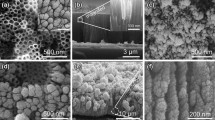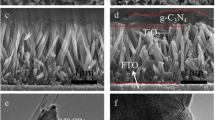Abstract
TiO2 nanocrystals are widely used in photoanodes for quantum dot solar cells (QDSCs) owing to their chemical stability and suitable energy band structure. However, surface defects and grain boundaries of TiO2 nanocrystals photoanodes allow high surface charge recombination, which limits the performance of QDSCs. In this work, an ultrathin TiO2 layer is introduced to the surface of TiO2 photoanodes by atomic layer deposition (ALD). The ultrathin layer not only reduces the surface defects of TiO2 nanoparticles and strengthens the connection between adjacent nanoparticles to suppress the charge recombination for improving the electron collection efficiency (ηcc), but also increases the surface energy of photoanodes to load more quantum dots (QDs) for enhancing the light harvesting efficiency (LHE). As a result, the solar cell based on CdS/CdSe QDs with ALD treatment exhibits an efficiency of 5.07% that is much higher than that of the cells without modification (4.03%).
摘要
TiO2纳米晶体具有稳定的化学性质和合适的能带结构, 因而被广泛应用在量子点太阳能电池的光阳极材料中. 但是, 其较多的表面缺陷 和颗粒边界引起的严重复合限制了电池效率. 本文利用原子层沉积法(ALD)在TiO2光阳极膜上沉积一层超薄TiO2层. 实验结果表明, 这层超 薄TiO2层不仅减少了表面缺陷, 改善了颗粒间的连接性, 阻止了复合的发生, 提高了电子收集效率, 而且通过表面能的提升, 量子点的吸附量 增加, 光捕获效率(LHE)也得以提高. 因此, 基于ALD修饰的TiO2膜制备的太阳能电池的效率达5.07%, 明显优于没有ALD 修饰的电池(4.03%).
Similar content being viewed by others
References
Kamat PV. Quantum dot solar cells. The next big thing in photovoltaics. J Phys Chem Lett, 2013, 4: 908–918
Tian J, Cao G. Control of nanostructures and interfaces ofmetal oxide semiconductors for quantum-dots-sensitized solar cells. J Phys Chem Lett, 2015, 6: 1859–1869
Tian J, Cao G. Design, fabrication and modification of metal oxide semiconductor for improving conversion efficiency of excitonic solar cells. Coordination Chem Rev, 2016, 320-321: 193–215
Carey GH, Abdelhady AL, Ning Z, et al. Colloidal quantum dot solar cells. Chem Rev, 2015, 115: 12732–12763
Du Z, Zhang H, Bao H, et al. Optimization of TiO2 photoanode films for highly efficient quantum dot-sensitized solar cells. JMater Chem A, 2014, 2: 13033–13040
Zhang J, Li S, Yang P, et al. Deposition of transparent TiO2 nanotubes-films via electrophoretic technique for photovoltaic applications. Sci China Mater, 2015, 58: 785–790
Tian J, Zhang Q, Uchaker E, et al. Architectured ZnO photoelectrode for high efficiency quantum dot sensitized solar cells. Energy Environ Sci, 2013, 6: 3542–3547
Wang Y, Tian J, Fei C, et al. Microwave-assisted synthesis of SnO2 nanosheets photoanodes for dye-sensitized solar cells. J PhysChem C, 2014, 118: 25931–25938
Kamat PV. TiO2 nanostructures: recent physical chemistry advances. J Phys Chem C, 2012, 116: 11849–11851
Chong B, Zhu W, Liu Y, et al. Highly efficient photoanodes based on cascade structural semiconductors of Cu2Se/CdSe/TiO2: amultifaceted approach to achievingmicrostructural and compositional control. J Mater Chem A, 2016, 4: 1336–1344
Toyoda T, Shen Q. Quantum-dot-sensitized solar cells: effect of nanostructured TiO2 morphologies on photovoltaic properties. J Phys Chem Lett, 2012, 3: 1885–1893
Ren Z, Wang J, Pan Z, et al. Amorphous TiO2 buffer layer boosts efficiency of quantum dot sensitized solar cells to over 9%. Chem Mater, 2015, 27: 8398–8405
Ito S, Liska P, Comte P, et al. Control of dark current in photoelectrochemical (TiO2/I−–I3−) and dye-sensitized solar cells. Chem Commun, 2005, 34: 4351–4353
Palomares E, Clifford JN, Haque SA, et al. Control of charge recombination dynamics in dye sensitized solar cells by the use of conformally deposited metal oxide blocking layers. J Am Chem Soc, 2003, 125: 475–482
Fei C, Tian J, Wang Y, et al. Improved charge generation and collection in dye-sensitized solar cellswithmodified photoanode surface. Nano Energy, 2014, 10: 353–362
Knez M, Kadri A, Wege C, et al. Atomic layer deposition on biological macromolecules: metal oxide coating of tobacco mosaic virus and ferritin. Nano Lett, 2006, 6: 1172–1177
Tallarida M, Das C, Schmeisser D. Quantum size effects in TiO2 thin films grown by atomic layer deposition. Beilstein J Nanotechnol, 2014, 5: 77–82
Chandiran AK, Yella A, Stefik M, et al. Low-temperature crystalline titaniumdioxide by atomic layer deposition for dye-sensitized solar cells. ACS Appl Mater Interface, 2013, 5: 3487–3493
Aarik J, Aidla A, Uustare T, et al. Morphology and structure of TiO2 thin films grown by atomic layer deposition. JCrystalGrowth, 1995, 148: 268–275
Knez M, Nielsch K, Niinistö L. Synthesis and surface engineering of complex nanostructures by atomic layer deposition. AdvMater, 2007, 19: 3425–3438
Detavernier C, Dendooven J, Pulinthanathu Sree S, et al. Tailoring nanoporous materials by atomic layer deposition. Chem Soc Rev, 2011, 40: 5242–5253
Niu W, Li X, Karuturi SK, et al. Applications of atomic layer deposition in solar cells. Nanotechnology, 2015, 26: 064001
Kim JY, Lee KH, Shin J, et al. Highly ordered and vertically oriented TiO2/Al2O3 nanotube electrodes for application in dye-sensitized solar cells. Nanotechnology, 2014, 25: 504003
Alibabaei L, Farnum BH, Kalanyan B, et al. Atomic layer deposition of TiO2 on mesoporous nano ITO: conductive core–shell photoanodes for dye-sensitized solar cells. Nano Lett, 2014, 14: 3255–3261
Lee HBR, Mullings MN, Jiang X, et al. Nucleation-controlled growth of nanoparticles by atomic layer deposition. Chem Mater, 2012, 24: 4051–4059
Brennan TP, Ardalan P, Lee HBR, et al. Atomic layer deposition of CdS quantum dots for solid-state quantum dot sensitized solar cells. Adv Energy Mater, 2011, 1: 1169–1175
Tian J, Gao R, Zhang Q, et al. Enhanced performance of CdS/CdSe quantum dot cosensitized solar cells via homogeneous distribution of quantum dots in TiO2 film. J Phys Chem C, 2012, 116: 18655–18662
Hamann TW, Martinson ABF, Elam JW, et al. Atomic layer deposition of TiO2 on aerogel templates: new photoanodes for dye-sensitized solar cells. J Phys Chem C, 2008, 112: 10303–10307
Yu L, Li Z, LiuY, et al. Synthesis of hierarchical TiO2 flower-rod and application in CdSe/CdS co-sensitized solar cell. J Power Sources, 2014, 270: 42–52
Sommeling PM, O'regan BC, Haswell RR, et al. Influence of a TiCl4post-treatment on nanocrystalline TiO2 films in dye-sensitized solar cells. J Phys Chem B, 2006, 110: 19191–19197
Tian J, Zhang Q, Zhang L, et al. ZnO/TiO2 nanocable structured photoelectrodes for CdS/CdSe quantum dot co-sensitized solar cells. Nanoscale, 2013, 5: 936–943
Gamelas JAF, Ferraz E, Rocha F. An insight into the surface properties of calcined kaolinitic clays: the grinding effect. Colloid Surf A-Physicochem Eng Asp, 2014, 455: 49–57
Mukhopadhyay P, Schreiber HP. Aspects of acid-base interactions and use of inverse gas chromatography. Colloid Surf A-Physicochem Eng Asp, 1995, 100: 47–71
Powar S, Wu Q, Weidelener M, et al. Improved photocurrents for p-type dye-sensitized solar cells using nano-structured nickel(ii) oxide microballs. Energy Environ Sci, 2012, 5: 8896–8900
Du J, Du Z, Hu JS, et al. Zn–Cu–In–Se quantum dot solar cells with a certified power conversion efficiency of 11.6%. J Am Chem Soc, 2016, 138: 4201–4209
Ren F, Li S, He C. Electrolyte for quantum dot-sensitized solar cells assessed with cyclic voltammetry. Sci China Mater, 2015, 58: 490–495
Ren Z, Wang Z, Wang R, et al. Effects of metal oxyhydroxide coatings on photoanode in quantum dot sensitized solar cells. Chem Mater, 2016, 28: 2323–2330
Hwang JY, Lee SA, Lee YH, et al. Improved photovoltaic response of nanocrystalline CdS-sensitized solar cells through interface control. ACS Appl Mater Interface, 2010, 2: 1343–1348
Kim B, Li Y, Jung H, et al. Enhanced interconnection of TiO2 nanoparticles using atomic layer deposition for flexible dye-sensitized solar cells with plastic substrates. Nano Lett, 2014, 09: 1440011
Kern R, Sastrawan R, Ferber J, et al. Modeling and interpretation of electrical impedance spectra of dye solar cells operated under open-circuit conditions. Electrochim Acta, 2002, 47: 4213–4225
Nakade S, Kanzaki T, Wada Y, et al. Stepped light-induced transient measurements of photocurrent and voltage in dye-sensitized solar cells: application for highly viscous electrolyte systems. Langmuir, 2005, 21: 10803–10807
Author information
Authors and Affiliations
Corresponding authors
Additional information
Ting Shen is a PhD candidate in Advanced Material and Technology Institute, University of Science and Technology Beijing. Her research is focused on interfacial modification of multi-component quantum dot and its photovoltaic properties.
Jianjun Tian is a professor in Advanced Material and Technology Institute, University of Science and Technology Beijing. His current research is focused on quantum dot sensitized solar cells and perovskite solar cells.
Guozhong Cao is a Boeing Steiner Professor ofMaterials Science and Engineering, Professor of Chemical Engineering, and Adjunct Professor of Mechanical Engineering at the University of Washington. He has published more than 300 papers, 7 books and 4 proceedings. His recent research is mainly focused on solar cells, lithium-ion batteries, supercapacitors, and hydrogen storage.
Rights and permissions
About this article
Cite this article
Shen, T., Tian, J., Li, B. et al. Ultrathin ALD coating on TiO2 photoanodes with enhanced quantum dot loading and charge collection in quantum dots sensitized solar cells. Sci. China Mater. 59, 833–841 (2016). https://doi.org/10.1007/s40843-016-5066-y
Received:
Accepted:
Published:
Issue Date:
DOI: https://doi.org/10.1007/s40843-016-5066-y




